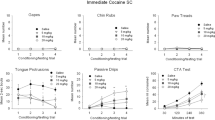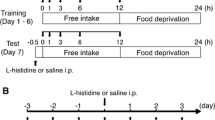Abstract
Two antiemetic drugs were tested on the expression of taste aversions previously conditioned in rats with lithium, amphetamine or morphine. Neither prochlorperazine nor scopolamine administered prior to testing attenuated established aversions, although both drugs are known to have antiemetic effects in other species. Negative findings were obtained with a range of doses of prochlorperazine and scopolamine, with strong and weak aversions, with one- and two-stimulus tests, in a repeated one-stimulus extinction procedure, with between- and within-group designs and with hooded, albino, male and female rats. The results do not support the widely accepted hypothesis that conditioned nausea mediates conditioned taste aversion.
Similar content being viewed by others
References
Barker LM, Smith J, Suarez EM (1977) ‘Sickness’ and the backward conditioning of taste aversion. In: Barker LM, Best MR, Domjan M (eds) Learning mechanisms in food selection. Baylor University Press, Waco, TX, pp 533–553
Berger BD, Wise CD, Stein L (1973) Area postrema damage and bait shyness. J Comp Physiol Psychol 82:475–479
Bernstein IL, Webster MM (1980) Learned taste aversions in humans. Physiol Behav 25:363–366
Blair R, Amit Z (1981) Morphine-conditioned taste aversion reversed by periaqueductal grey lesions. Pharmacol Biochem Behav 15:651–653
Booth DA, D'Mello GD, Pilcher CWT, Stolerman IP (1977) Comparative potencies of amphetamine, fenfluramine and related compounds in taste aversion experiments in rats. Br J Pharmacol 61:669–677
Borison HL (1974) Area postrema: Chemoreceptor trigger zone for vomiting — is that all? Life Sci 14:1807–1817
Cappell H, Le Blanc AE (1975) Conditioned aversion by psychoactive drugs: Does it have significance for an understanding of drug dependence? Addict Behav 1:55–64
Coil JD, Hankins WG, Jenden DJ, Garcia J (1978a) The attenuation of a specific cue-to-consequence association by antiemetic agents. Psychopharmacology 56:21–25
Coil JD, Rogers RC, Garcia J, Novin D (1978b) Conditioned taste aversions: Vagal and circulatory mediation of the toxic unconditioned stimulus. Behav Biol 24:509–519
D'Mello GD, Goldberg DM, Goldberg SR, Stolerman IP (1981) Conditioned taste aversion and operant behavior in rats: Effects of cocaine, apomorphine and some long-acting derivatives. J Pharmacol Exp Ther 219:60–68
Gadusek FJ, Kalat JW (1975) Effects of scopolamine on retention of taste-aversion learning in rats. Physiol Psychol 3:130–132
Garcia J, Ervin FR (1968) Gustatory-visceral and telereceptor-cutaneous conditioning: Adaptation in internal and external milieus. Commun Behav Biol (A) 1:389–415
Goudie AJ (1979) Aversive stimulus properties of drugs. Neuropharmacology 18:971–979
Goudie AJ, Dickins DW (1978) Nitrous oxide-induced conditioned taste aversions in rats: The role of duration of drug exposure and its relation to the taste aversion-self-administration paradox. Pharmacol Biochem Behav 9:587–592
Grote FW, Brown RT (1971) Conditioned taste aversions: Two-stimulus tests are more sensitive than one-stimulus tests. Behav Meth Res Instrum 3:311–312
Infurna RN, Spear LP (1979) Developmental changes in amphetamine-induced taste aversion. Pharmacol Biochem Behav 11:31–35
Kiefer SW, Rusiniak KW, Garcia J, Coil JD (1981) Vagotomy facilitates extinction of conditioned taste aversion in rats. J Comp Physiol Psychol 95:114–122
Riley AL, Jacobs WJ, LoLordo VM (1978) Morphine-induced taste aversions: A consideration of parameters. Physiol Psychol 6:96–100
Ritter S, McGlone JJ, Kelley KW (1980) Absence of lithium-induced taste aversion after area postrema lesion. Brain Res 201:501–506
Stolerman IP, D'Mello GD (1981) Oral self-administration and the relevance of conditioned taste aversions. In: Thompson T, Dews PB, McKim WA (eds) Advances in behavioral pharmacology, vol 3. Academic, New York, pp 169–214
Stolerman IP, Pilcher CWT, D'Mello GD (1978) Stereospecific aversive property of narcotic antagonists in morphine-free rats. Life Sci 22:1755–1762
Wang SC (1965) Emetic and antiemetic drugs. In: Root WS, Hofmann FG (eds) Physiological pharmacology, vol 2. Academic, New York, pp 255–328
Winer BJ (1971) Statistical principles in experimental design. McGraw Hill, London
Author information
Authors and Affiliations
Rights and permissions
About this article
Cite this article
Goudie, A.J., Stolerman, I.P., Demellweek, C. et al. Does conditioned nausea mediate drug-induced conditioned taste aversion?. Psychopharmacology 78, 277–281 (1982). https://doi.org/10.1007/BF00428165
Received:
Accepted:
Issue Date:
DOI: https://doi.org/10.1007/BF00428165




